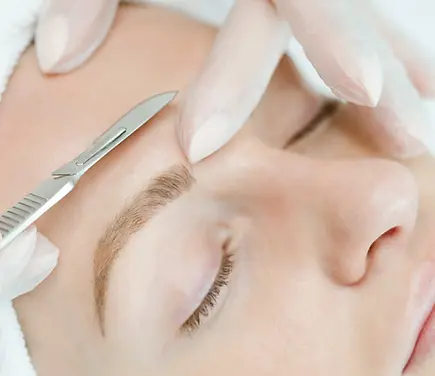Dermaplaning

Benefits of Dermaplaning:
Dermaplaning promotes smoother, brighter, and more radiant skin by removing dull, keratinized cells and fine facial hair. This treatment may reduce the appearance of fine lines, wrinkles, and acne scars while enhancing the skin's ability to absorb active ingredients from professional skincare treatments and products. It is also an excellent preparatory step before other treatments, such as chemical peels or masks, as it creates an even surface for optimal results.
What to Expect During Treatment:
The process begins with a comprehensive skin analysis and the creation of a personalized skincare plan tailored to individual needs. The skin is thoroughly cleansed to remove impurities and prepare for exfoliation.
Exfoliation involves the Medical Specialist using a surgical blade to gently glide across taut skin, starting at the forehead and working down the cheeks and chin, while avoiding sensitive areas like the eyebrows, nose, and lips. The technique is precise, painless, and carefully controlled to ensure safety and effectiveness.
After the exfoliation, a soothing scalp massage is provided while a customized mask is applied, targeting the skin's specific needs. The treatment concludes with the application of finishing products designed to calm, hydrate, and protect the skin, leaving it smooth, refreshed, and glowing.

Dermaplaning Treatment - $150
Dermaplaning is a safe and effective exfoliation technique that uses a sterile surgical blade held at a precise 45-degree angle to gently remove the outermost layer of dead skin cells and fine vellus hair. This professional treatment is performed by a trained Medical Specialist to enhance skin texture and improve the overall appearance of the complexion.
01
Is Dermaplaning safe?
Frequently Asked Questions
1
Who can perform Dermaplaning?
An RPN/RN, licensed aesthetician, or cosmetologist who has been professionally trained can perform the treatment.
2
Is Dermaplaning safe?
Yes, Dermaplaning is safe when performed by a properly trained professional.
3
How should I prepare for a Dermaplaning treatment?
Discontinue other aggressive skincare treatments involving retinoids, AHA’s, BHA’s or micro-beads 3 days prior to treatment to avoid over exfoliation.
Avoid sun exposure.
If your skin becomes sensitized before treatment, consider rescheduling or changing the procedure to better suit your needs.
Be sure to schedule facial waxing 1-2 weeks prior to your dermaplaning treatment.
Be mindful of scheduling other cosmetic treatments such as neuromodulator or dermal filler injections. These treatments should be performed on different days recommended by your Medical Specialist to avoid adverse reactions.
4
Once the vellus hair is removed, will it grow back thicker?
No, vellus hair will typically grow back within 4 weeks. It is physiologically impossible for other depilatory forms such as dermaplaning, shaving, waxing, or tweezing to alter the type of hair grown in any given area.
5
Can dermaplaning cause the skin to bleed?
Yes, there is a slight chance of bleeding if the skin undergoes any inadvertent nicks, cuts, or excessive scraping. Your Medical Specialist has been properly trained to do everything to mitigate any risks.
6
What areas on the body can be treated?
Dermaplaning should only be performed on the face. You should not Dermaplane the chest, throat, beard or scalp hair, or eyelids.
7
How often can Dermaplaning be performed?
Dermaplaning is recommended every 4 weeks in order to remove the top 2 to 3 weeks worth of dead skin cell build-up.
8
Can Dermaplaning be performed with a peel?
Yes, if deemed appropriate and safe by your Medical Specialist, Dermaplaning is an excellent way to prepare the skin for most peels.
9
Does the skin actually peel from dermaplaning?
The skin does not “peel” from Dermaplaning, however there will be an accumulation of dead skin and hair on the blade as it travels over the skin. If dermaplaning is performed as a preparation for a chemical or enzyme peel, and there is visible “peeling” of the skin at a later date, it would be a result of the peel product used in the treatment, not the Dermaplaning.
10
Who can/can not be treated?
Dermaplaning can benefit all skin types, though may be contraindicated due to some health conditions. Examples of contraindicated health conditions include though not limited to:
Active acne breakouts should be treated only after lesions have healed.
Rosacea or other skin conditions causing inflammation.
Open wounds or active infections.
Bleeding or clotting disorders.
Uncontrolled diabetes.
Ongoing cancer treatments.
Active cold sores require rescheduling; individuals prone to cold sores should begin pre-medication 24 hours prior to treatment.
Treatments scheduled within one year of the last dose of Accutane are not recommended.
